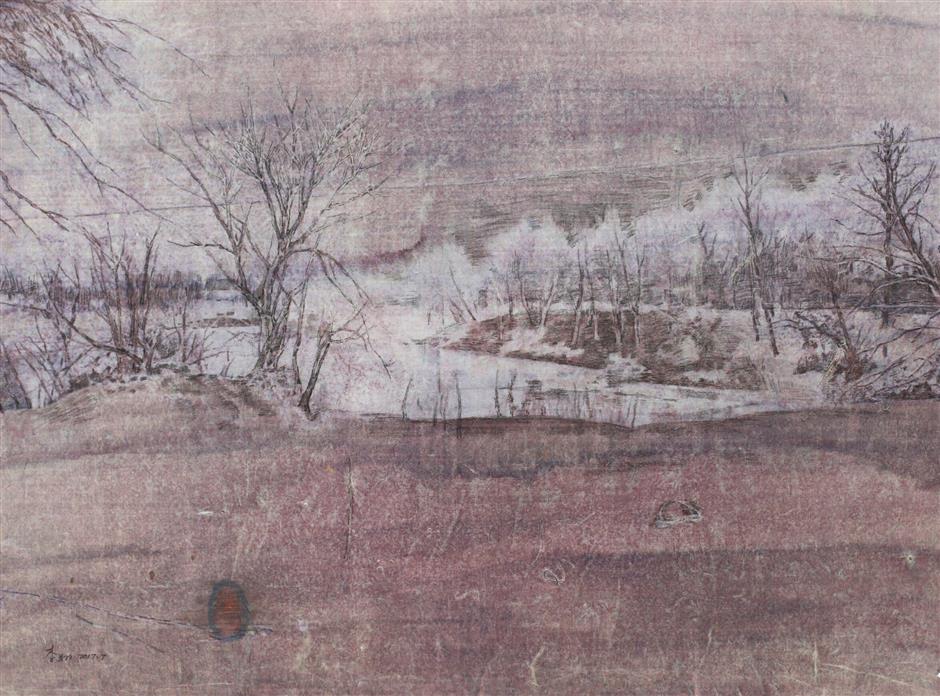Seeing the world with a soft and sensitive heart
Li Xiang often calls himself “a lonely walker.” Living in his hometown for several decades, the self-taught artist is like a recluse, ignoring all the outside hustle and bustle.
Born in 1961 in Yangzhou, Jiangsu Province, Li’s name is little known in the art community, let along his artworks.
Currently, he has a solo exhibition entitled “Suburbs” at Shanghai Gallery on the Bund featuring a cluster of oil and acrylic on paper.
Yangzhou in eastern China was once an economic and cultural hub during the Ming (1368-1644) and Qing dynasties (1644-1911).
“There is a kind of atmosphere in Li’s paintings that unwittingly echoes with the ambiance of today’s Yangzhou,” says Shanghai art critic Shao Qi. “Whether the horizon, the fields, the telegraph poles or the jungles under his brush, they all seem to imply a loss in fate.”
Li is enamored of conjuring up a distant and desolate world with no traces of humans.
He is also fascinated in depicting a snow-covered scene, reminiscent of the ending of “Dream of the Red Chamber” — “Like birds who, having fed, to the woods repair; they leave the landscape desolate and bare.”
Li hides himself in his studio renovated from a garage without air-conditioning. He confesses he treasures every moment there during the four seasons.
“I am very grateful to my family that fully supports my pursuit in art,” Li said, “I feel fortunate that I can live as an artist, so that I have a more profound spiritual world to experience life and art.”
Perhaps it is quite late for an artist to have his solo exhibition at the age of 57, but Li said that he has never complained or held a grudge about late recognition.
“Someone said they find something cool and cruel in my paintings, but I don’t agree,” he says. “I actually see the world with a soft and sensitive heart.”

Artist Li Xiang at work. His painting echoes his attitude toward a simple life.
Q: A melancholy ambiance can be sensed in your work. Is that on purpose or unwitting? Are you a pessimist?
A: The ambiance that the viewers find in my paintings actually echoes my attitude toward my life.
Or to be more exact, it is a mirror of my spiritual world, and surely I created such an atmosphere on purpose.
What I have encountered in my life becomes the “stimulation” in my art. I always keep a curious heart for the unknown and mysterious. In fact, I don’t have any reason to be pessimistic.
Q: Jiangsu Province doesn’t seem to be active in China’s art scene. As an artist living there for several decades, do you think the city nurtures you or hinders your development in art?
A: Let me use the example of Swiss architect Peter Zumthor to answer the question.
Zumthor avoids and stays away deliberately from all kinds of centers and lives in a small village in Switzerland. But after three decades of his devotion to design, he garnered the Pritzker Prize, Nobel-equivalent for architecture, in 2009.
I also think that under today’s globalization, there is actually no ignored corner around the world. The special geographic location, the history, culture and even the smell of Yangzhou combine to nurture my heart and soul in art.
Q: Some critics say they see Anselm Kiefer and Giorgio Morandi in your paintings. Do you like both artists’ works?
A: Yes, these two artists are my favorite ones, and I also particularly pay visits to their exhibitions in China.
What Kiefer inspired me was his vision and aggression, while what I was obsessed with Morandi was his purity and simplicity.
Morandi spent most of his life in his native town of Bologna, both living and painting in his flat, and seldom venturing far afield. He repeatedly painted the same selection of familiar items, including bottles, bowls, pots and boxes.
I am quite moved by his way of “creating a kind of one piece of painting through his entire life.”
Q: Can you use three words to describe your paintings?
A: Strange, chaotic and lonely.

“Strange Landscape”
Q: It is said that you lead a simple life in Yangzhou. Why is that?
A: In my eyes, simple life brings me joy. I believe in eating delicious food and having a warm family.
My belief comes from art with an overwhelming power to bring people together.
As an artist, I am very sensitive to experience the condition of being and the way to express it. In fact, my thinking, reading and traveling are both related to art.
Q: What was the darkest moment in your life and how did you overcome it?
A: At my age, I have savored all I have to savor. The vicissitudes of society carries each individual forward and there is no escape. Yet fortunately, I could always deal with these changes like an observer or outsider. So there is no so-called darkest moment in my life.
Q: Your paintings reflect some humanistic care with a narrative power. What’s your favorite movie or novel?
A: People of my generation went through a mad passion for literature in the 1980s under the impact of the reform and opening-up policy.
My favorite writer is Lu Xun whom I consider that no one could surpass in revealing and criticizing the national characters of the Chinese.
“Forrest Gump” is the movie I prefer the best. The swaying feather flowing in the sky at the beginning of the film deeply unveils the value and meaning of a human being.

“Fence” series
















